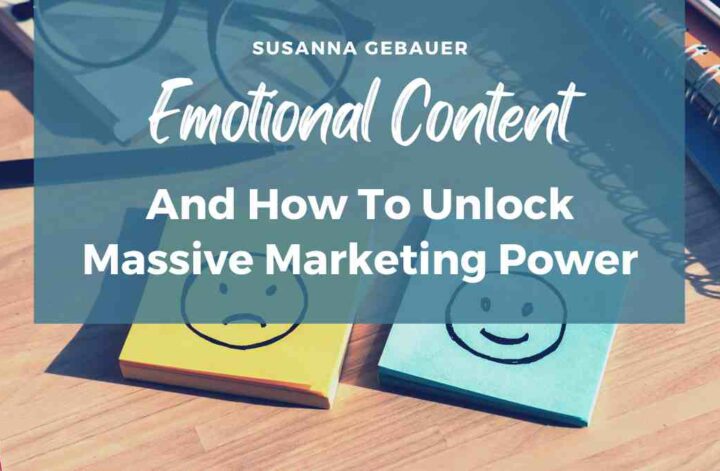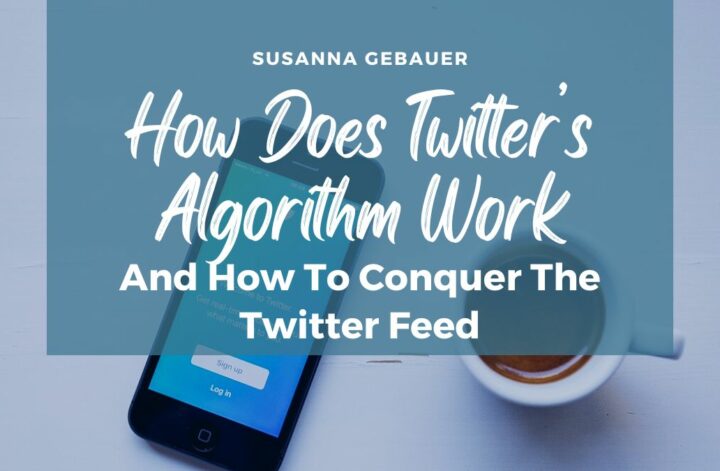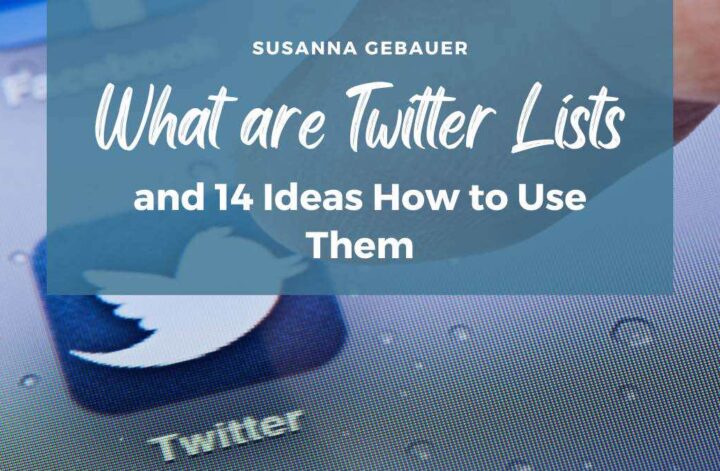Emotions are a powerful force. They can motivate us, inspire us, and even change our behavior. That makes emotional content so effective in marketing.
I don’t know about you, but I sure take different actions and make different decisions if my emotions are boiling.
And that’s why some content has the power to build community and sell like crazy and other content that contains the same tips and value passes by unnoticed and without generating the results you were hoping for:
- Emotional content inspires reactions and people remember what they felt consuming it
- Purely fact-based content will get lost in the big bucket of valuable content and not stand out.
Learning to incorporate emotions into our content creation is key to having serious success with social media, blog content, and sales messages.
Here is what you will learn in this post (it’s a long post, feel free to skip parts that are not interesting to you):
- What are emotions?
- What are emotional triggers?
- How do emotions affect decision-making?
- Which emotions have the most influence on our decisions?
- The power of emotions in content marketing
- Here are the emotions that make people share
- These emotional triggers will help you sell more
- How can you evoke the right emotions in your content?
- Examples of emotional content marketing
- How far from your main topic should you stray with your emotional stories?
There are emotions that trigger actions and the lack of emotions makes content boring and replaceable.
I have learned the hard way that emotional content has more power and a purposeful use of emotional triggers can bring you massive marketing success – the lack thereof will let your content utterly fail.
What are emotions?
When writing this article, I got stuck on answering this in simple words. So I asked Google Bard. Here is what it said:
Emotions are complex psychological phenomena that involve physiological, behavioral, and cognitive components.
Helpful? I don’t know. Let me try to put it in my own words:
Emotions are strong feelings that trigger actions and that also impact your health of body and mind. Emotions are triggered externally by events or behavior of people around you or internally by your thoughts and experiences from your past.
There are positive emotions like happiness, joy, and love and negative emotions like anger, sadness, and fear.
But positive or negative emotions are not black and white.
For instance, a horror movie may induce fear that you consider enjoyable which turns fear into a positive emotion in this special case.
What are emotional triggers?
Emotions are triggered by events, people, or situations. These emotional triggers can cause us to experience strong emotions. Emotional triggers can vary from person to person due to past experiences and personality.
A simple example is that some people react with strong emotions to what other people say while other people won’t react at all to the same behavior.
Some common emotional triggers include:
- Negative experiences: These can include things like trauma, abuse, or neglect. When we experience these events, they can leave us with a lasting emotional response that can be triggered by similar events or situations in the future.
- Current events: These can include things like political events, natural disasters, or even the death of a celebrity. When we are exposed to these events, they can trigger strong emotions that can be difficult to control.
- Our imagination: Our imagination can also be a source of emotional triggers. If we have a fear of spiders, for example, simply thinking about a spider can trigger a feeling of anxiety or fear.
How do emotions affect our decision-making?
A huge part of our decision-making takes place in the subconscious.
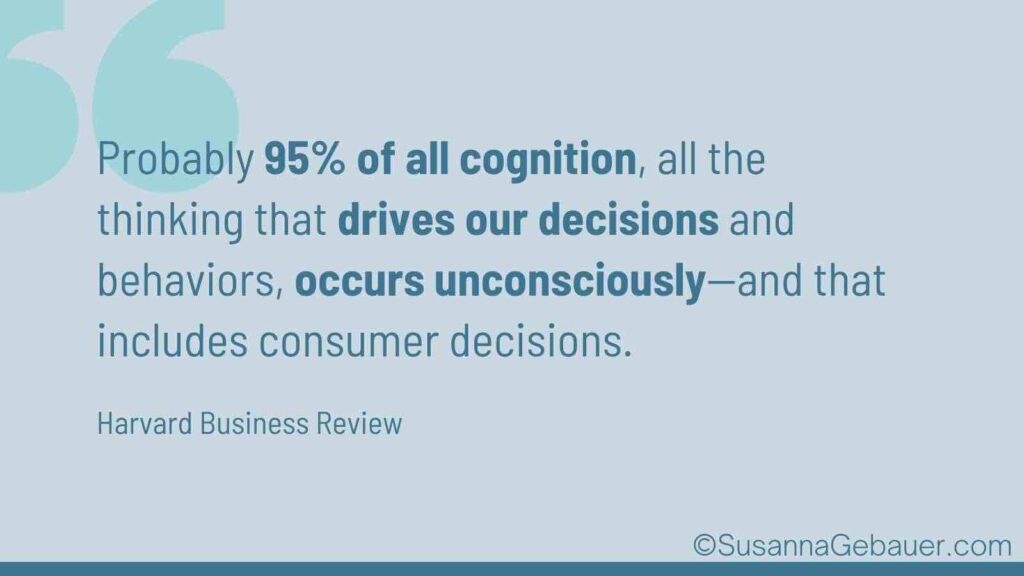
Even if we make a list of pros and cons and try to make the process as objective and conscious as we can, every small decision, every pro or con on our list is influenced by emotions and past experiences.
In marketing, we try to influence the conscious decision process:
- we provide technical data and facts about a product
- we explain the benefits
- we provide comparisons with competing products
- and a lot more
But that is not enough.
Probably 95% of all cognition, all the thinking that drives our decisions and behaviors, occurs unconsciously—and that includes consumer decisions. That’s not to say that the 5% we’re privy to is unimportant—just that marketers overemphasize its importance, because it’s so visible and easy to access.
Harvard Business Review
Source: Harvard Business Review
Because we have to speak to the subconscious, the emotional mind of our potential customers.
You may have wondered (I sure did when I realized it) why some people don’t need elaborate landing pages, they don’t need fancy product descriptions, or elaborate sales tricks.
Often, the answer is that they excel at using emotional content to build community. Mental triggers and emotional content inspire actions from their audience. This emotional content usually comes in the form of stories these people tell.
There are different ways emotions can influence our decisions:
Direct or integral emotions
Anxiety and fear of the result of an action from us may lead us to make a safer decision. If you are angry with someone, you may not meet them although from a rational point of view, you would have.
Incidental Emotions
Emotions can carry over from one situation to another. Emotions like anger or fear that we experience in a certain situation may trigger the same emotion in another situation without us even noticing why we feel this emotion now.
For example, my dog was shot beside me in the forest when I was seven. For years, I felt fear in the forest and I could not understand why I felt this way until I grew up and realized the connection.
Positivity or negativity of emotions (Emotional Valence)
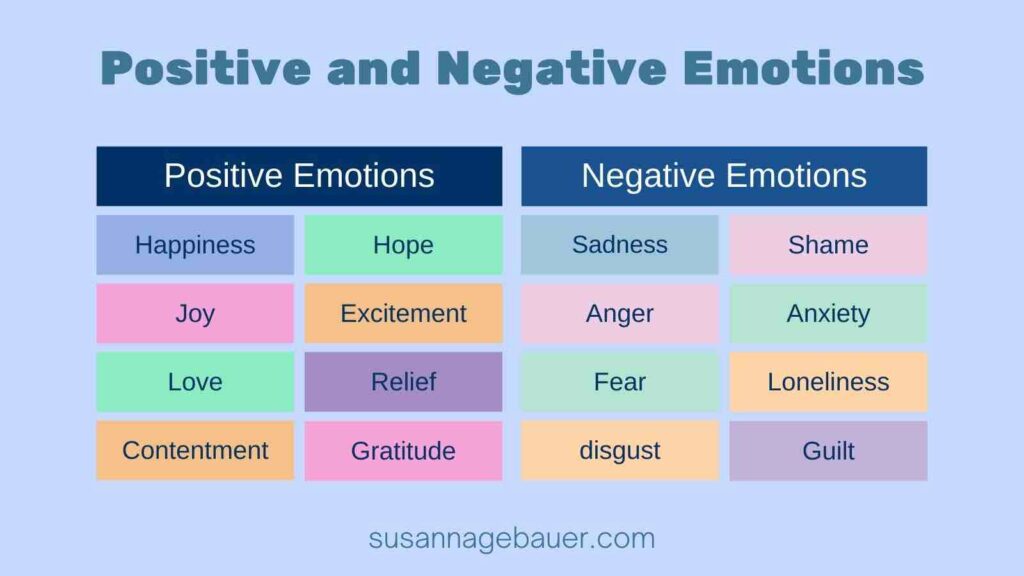
Emotional valence is the degree to which an emotion is positive or negative. It is a fundamental dimension of emotion that is often used to categorize emotions.
Positive emotions motivate us to approach or engage with something, and negative emotions make us avoid or withdraw from something.
Positive emotions are happiness, joy, love, contentment, relief, hope, excitement, and gratitude.
Negative emotions are sadness, anger, fear, disgust, guilt, shame, anxiety, and loneliness.
Content of thought
The concept of content of thought brings the individual perception and reaction to emotions into the mix. Every individual reacts differently to emotional triggers. This individuality is based on a couple of factors like:
- Perceptions: What the individual is aware of in the present moment.
- Thoughts: The individual’s own thoughts, beliefs, and opinions.
- Affect: The individual’s emotional state.
- Memory: The individual’s ability to remember past events.
- Judgment: The individual’s ability to make decisions and reason.
Depth of thought (depth of information processing)
Emotions can signal when additional attention is demanded. Thus negative emotions can result in more vigilant and systematic processing while positive emotions can incur a feeling of safety and lead to more heuristic decisions.
Interpersonal decision-making
Decisions are influenced by other people, how they react toward us and what our relationship with these people is like.
We know this from peer pressure, for instance, when children want an expensive piece of clothing not because they need it but rather because their friends have it or because they feel like the odd one out if they don’t have it.
When everybody around you has a strong opinion about something, it is sometimes hard to know what your own opinion is. The feeling of “Can everybody please shut up, I have to make up my own mind” can be strong.
Here are some ways, interpersonal relationships can influence human decisions:
- Problems to preserve your own free will
- Restricting a person’s perspective
- Dependence in a relationship (“What would my husband say if I do this?”)
- Suggestions with the goal of influencing the decision
- Denying facts
These are all connected. What is important is to understand that the people around us influence our decisions – sometimes that is good, sometimes not.
For making sales that often means: if people start buying and talking in a positive way about your products that is when more people hop on the train and start buying too.
Which emotions have the most influence on our decisions?
How we feel influences the decisions we make.
From the decision of what we will have for breakfast and the decision if we meet friends for dinner until the time we go to bed: Emotions trigger how we spend our day.
Some decisions are made to avoid a certain emotion, other decisions are made to evoke emotions. Stronger emotions have more influence on our decisions than weak emotions.
It’s hard to say which emotions have the most influence on our decisions as this always depends on the individual and their past experiences, the situation, and the type of decision you are trying to make. However, some emotions are known to induce strong feelings and have a significant impact on decision-making:
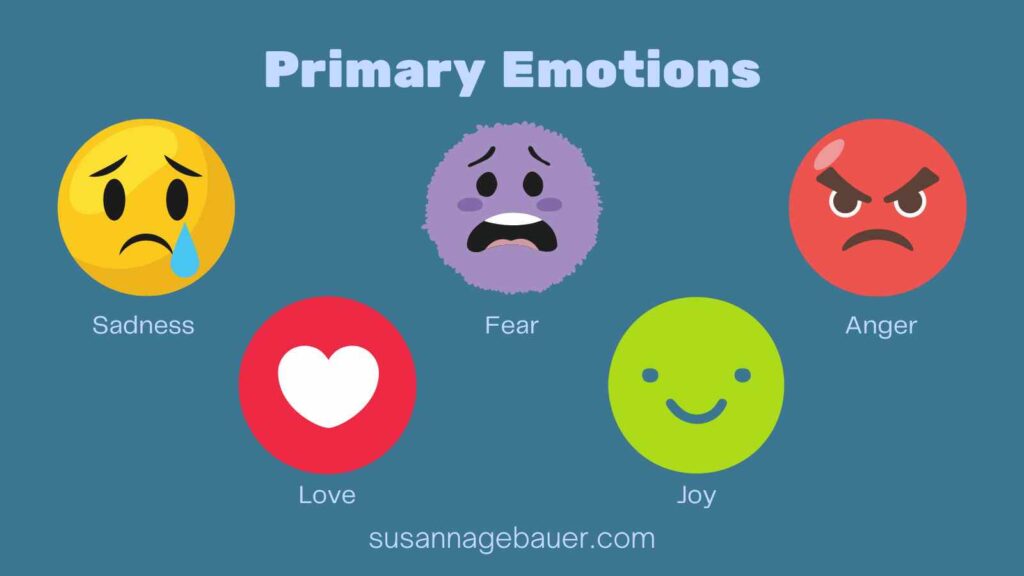
- Fear: Fear is something we don’t want to feel. We try to avoid it through procrastination, and impulsive decision-making. For example, someone who is afraid of public speaking may avoid giving presentations, or someone who is afraid of failure may procrastinate on a project. Fear can be a big roadblock.
- Anger: Anger can lead to aggression, impulsiveness, and poor judgment. For example, someone who is angry with a coworker may say something hurtful or make a rash decision. I, for instance, know that I should not respond to social media comments that make me angry on impulse. I need to let my anger boil down before I answer.
- Sadness: Sadness can lead to withdrawal, rumination, and poor concentration. For example, someone who is feeling sad about a breakup may withdraw from their friends and family, or they may have difficulty making decisions about their future.
- Joy: Joy can lead to optimism, risk-taking, and creativity. For example, someone who is feeling happy about a new job offer may be more likely to take a risk and move to a new city. You may remember your first sale and the feeling of energy and new ideas that you felt that instant – I sure do!
- Love: Love can lead to loyalty, commitment, and sacrifice. For example, someone who is in love with their partner may be more likely to make decisions that are in the best interests of their relationship.
In addition to these primary emotions, there are also secondary emotions.
While primary emotions are instinctive, primal, and sensitive, secondary emotions are reactions to primary emotions and are more habitual or learned responses.
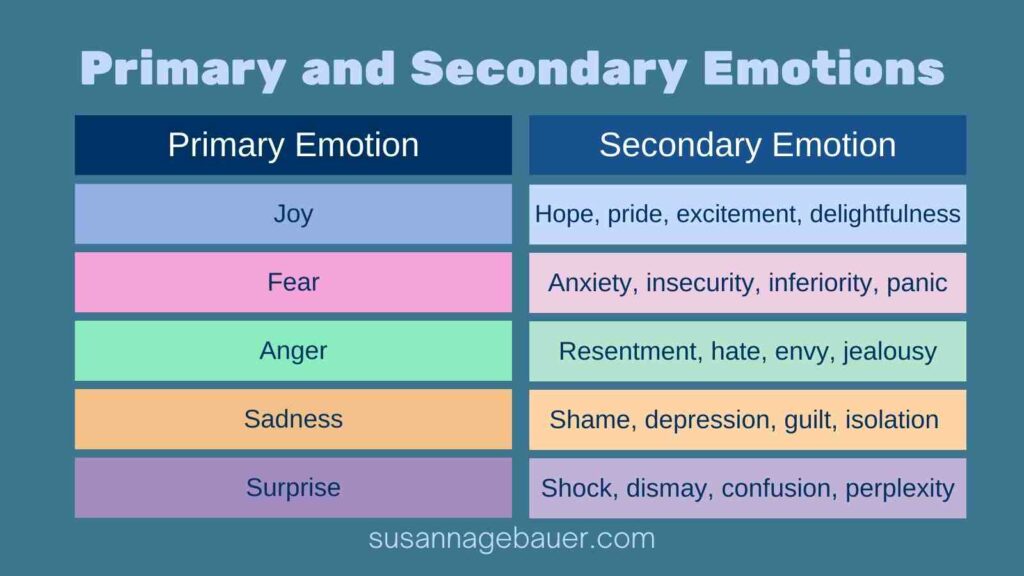
Emotions can also have a positive impact on decision-making. For example, fear can motivate us to take action or work harder, anger can help us to stand up for ourselves, and sadness can help us to appreciate the good things in our lives.
Ultimately, the best way to make decisions that are aligned with your values and goals is to be aware of your emotions and how they are influencing your thinking. By taking the time to pause and reflect on your emotions, you can make more informed and deliberate decisions.
Here are some tips for making decisions when you are feeling emotional:
- Take some time to calm down: If you are feeling overwhelmed by your emotions, it is important to take some time to calm down before making a decision. This will help you to think more clearly and make a decision that is in your best interests.
- Talk to someone you trust: If you are struggling to make a decision, it can be helpful to talk to someone you trust. They can offer you support and guidance and help you to think through your options.
- Consider the long-term consequences: When you are making a decision, it is important to consider the long-term consequences of your actions. Don’t just make a decision based on how you feel in the moment. Think about how your decision will affect you in the future.
- Do your research: If you are making a big decision, it is important to do your research. This will help you to gather all of the information you need to make an informed decision.
Making decisions when you are feeling emotional can be difficult. However, by following these tips, you can make sure that you are making decisions that are in your best interests.
So far, I have talked about how emotions influence our decisions, and how they impact our decision-making.
Now, it is time to turn sides and take a look at how we can use emotions in our marketing content to get our audience to make decisions in our favor.
The power of emotions in content marketing
Content marketing is the art of strategically using content to drive customer action.
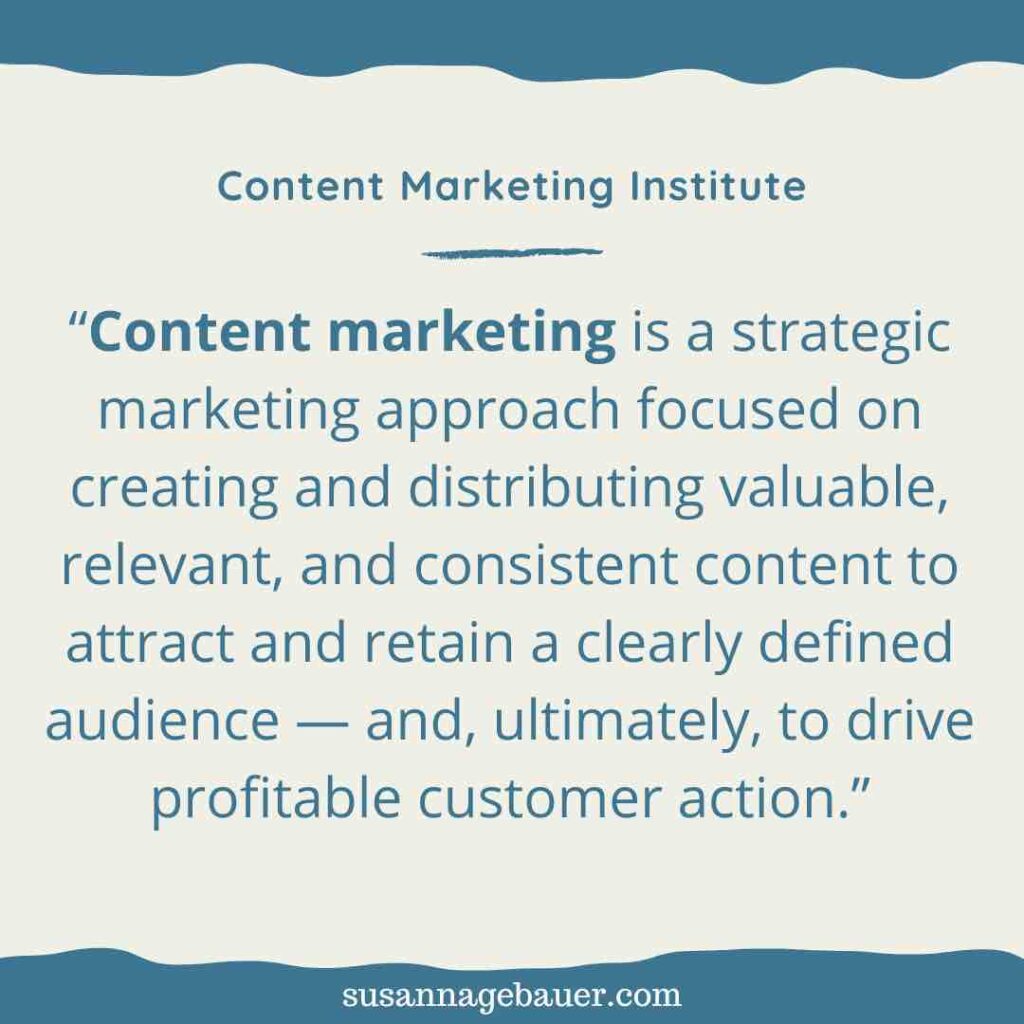
But every beginner content marketer will have to learn that not every piece of content has the same power to get results as some other pieces of content – even if you provide the same tips and use similar keywords.
That leads to the questions: What makes the content work in your desired way and what is the content lacking that does not give you the results you were seeking?
The answer often is the emotions a piece of content makes us feel.
Besides the value of the content for your target audience and your distribution strategy, the emotions you evoke with your content play a huge factor in branding, distribution, and conversions.
Why are emotions important in content marketing?
Emotions and feelings are huge triggers of reactions.
- Anger often results in outbursts or shouting.
- Sadness makes us cry.
- Love makes us want to hug or kiss someone.
After consuming a piece of content, you will remember the way it made you feel. If your audience did not feel anything when consuming your content, they will forget about it fast.
Just think about the last book you read and loved. You will remember it because of the feelings it brought you.
But there is more:
Not only the emotions a piece of content evokes make us take action. We also have the drive to feel certain emotions and do things that we believe will get us there. We will gladly make a little effort if we think it will make us happy.
Sales content often plays with promises of emotions you can achieve if you only buy a product.
Which emotions have the most marketing impact
The first thing you have to understand is that different emotions inspire different actions. If you want people to share your content, you should focus on different emotions than if you are trying to sell something.
The second thing that you have to keep in mind is that emotions rarely come as one. Most of the time, it is a mix of emotions that lead us to a decision. But often one emotion is the dominant one.
And the third thing is, not everybody will feel the same emotions after consuming a piece of content. I can remember that my brother used to like totally different pieces of content and content marketers than I did. Simply because we both have a different personality.
Here are the emotions that make people share
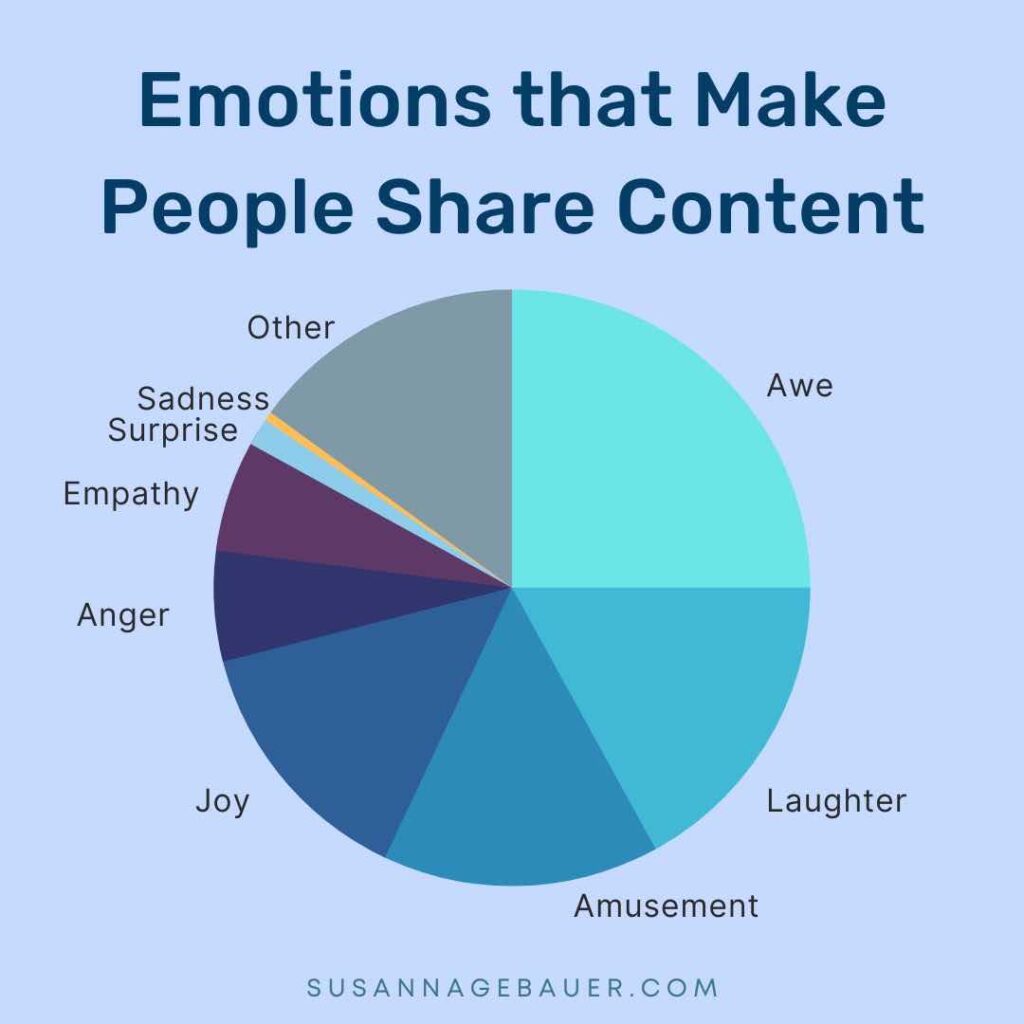
Buzzsumo analyzed the top 10% of content that gets shared online. They examined which emotions the content evokes, and which emotions increase the probability of a piece of content getting shared.
Here are the emotions that had the most impact on sharing behavior for a piece of content:
- Awe
- Laughter
- Amusement
- Joy
- Anger
- Empathy
- Surprise
- Sadness
Data Source: Business Insider
These emotional triggers will help you sell more
At its heart, all human decisions are driven by the need to avoid pain and gain pleasure.
You can use this knowledge to nudge your audience in the direction of buying your product. Simply give them the impression that your product is going to avoid pain for them and helps them to gain pleasure.
There are a couple of emotional buttons you can push to achieve this and sell more products – if you have studied sales funnels and product launches, you may recognize some of the mental triggers that are involved here:
Fear:
Fear comes in many colors.
The fear of missing out is a strong power when it comes to selling. Scarcity plays with this fear by creating a sense of urgency through a ticking counter.
Another way of playing the fear card for sales is to incur the feeling that one cannot succeed without your product or if they don’t get your product they will be the only one left behind.
But there is more to fear: The fear of doing something wrong, hurting someone, the fear of getting hurt or losing something.
Trust, power, and social proof
Trust is one of the most important emotions when it comes to selling. You may succeed in pushing the fear of missing out button, if a potential customer does not trust you they may still not buy.
On the other hand, a trusting audience that firmly believes you will only present them with the best possible solution may buy from you without further hesitance or questions.
You can see this with successful online entrepreneurs with an engaged and trusting audience: Every new product they launch is an instant success simply because their audience trusts them.
Social proof, testimonials, and long-term relationships all help you to grow trust.
Trust is why long-term subscribers that you nurtured with many valuable email newsletters, tips, and free content will be more likely to buy a new product from you than chance website visitors who had never heard your name before they found your blog post via Google search.
Value and Gratitude:
There is actual value and there is perceived value.
To increase your sales, you need to increase the perceived value for your potential customers.
Decisions are often based on the question: Where do I get the most value for my money?
That is why many sales pages include comparison tables between products and competing products. Another way to use value to increase sales is to provide a ton of value for free until your audience feels like “If I get so much value for free, how good will the paid product be?” – This goes straight in line with building trust and incurring gratitude.
Or you play the reciprocity card and make your audience feel something like “I already got so much for free, I will pay for a product now.”
What you want is for your audience to feel like: Wow, so much value for this little money? I need this.
To increase the perceived value, you can also use bonuses.
Keep in mind that the value for your customers is their benefits and the improvement they can achieve with your product. The value is not about the most advanced technology or features.
Value can also be instant gratification or ease of access.
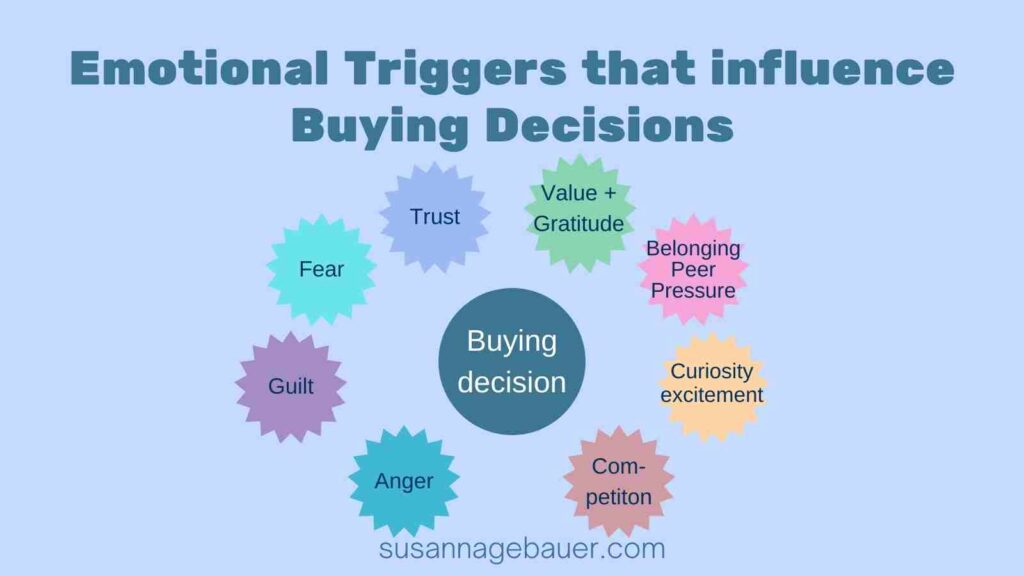
Belonging, Community, or Peer Pressure
Can you remember the times in our childhood when we wanted the white Nikes because all our friends got the white Nikes? Or maybe it wasn’t Nike but some other brand that functioned as a symbol of belonging.
That is peer pressure or a feeling of belonging.
The same can hold true for selling to a community.
If everybody buys this product we don’t want to be the odd one out. And if everybody else believes in this, why should I doubt it?
You may have noticed some sales sections at the end of a webinar where the speaker welcomes people to the product. This is about trust, sure. But it is also about peer pressure and community. We are influenced by other people. If you are not convinced yet, you may still buy if other people buy first.
While sometimes we want to be the first to buy (the newest Apple product), there are also situations where being the first takes more courage, and seeing someone else take the leap to buy can be the little nudge we need to make us hit the buy button. This happens when the brand is new, we never bought anything from them before or we have doubts that buying this offer is safe.
Curiosity, excitement, novelty, anticipation
That long queue in front of an Apple store when a new product launches? They don’t all desperately need the Apple product right now. But it’s new and they “need” to have it as soon as possible.
That is about excitement and novelty.
Apple excels at playing this card. They build up tension and curiosity toward a product launch.
It is also what a typical launch is about. Use emails and messages to build up tension toward the product release. If you do it right, people are ready to check out your offer when you post “cart open.”
Guilt (reciprocity)
It is not all about positive emotions. The guilt factor is a powerful one, too.
Think about images of starving children or animals. These are used to get donations to a cause. Part of why they work is that they play with our guilt (“I am so much better off, let’s donate to feel better.”) and with compassion.
You may not agree that I put reciprocity into the “guilt” section. But for me, they both work in a similar way.
Reciprocity is the urge to pay someone back – not in money but in kindness or value. That is a form of guilt that we feel when someone gave us something or did something for us and we did not (yet) return the favor.
Anger
Anger is a strong emotion with a strong influence on our actions.
Think about your past, I am sure you can come up with some actions you made because you were angry. Typical reactions are shouting, and angry messages but we may also buy something in an angry mood that we would otherwise not have bought. Often we regret these purchases later – anger is not a good guide when it comes to buying decisions.
Competition
Most of us have experienced situations where we wanted to have something just because someone else had it.
Children and adolescents are prone to this emotion but we adults are not immune against it.
If having a product provides some status and not having it makes you feel less valued, competition is a huge buying factor.
Love and likeability
Have you ever felt that maybe someone was offering you the product you needed, but you simply did not like the person making the offer?
I have multiple times. And I don’t like to buy from people I don’t like!
It works the other way around, too. If I like someone, my decision to buy from them is so much easier!
Once we are pointed to these emotions, we can instantly recognize some of them in every sales letter or sales page.
How can you evoke the right emotions in your content?
It is all very interesting to know and understand how emotions influence our behavior.
But the important step is to learn to create content that triggers the most effective emotions. Creating emotional content may not come naturally for everyone but it can be learned. Some basic concepts will help you to create more emotional content that will push the right buttons with your audience.
Use emotional storytelling:
Stories are a powerful way to connect with people on an emotional level. When you tell a story, you’re inviting your audience to share your experience and feel your emotions.
Often the stories we tell are about situations and struggles similar to the ones faced by our audience. These stories build trust and a feeling of community, empathy, and belonging. The stories then move on to the solution which builds on envy and desire.
Stories for sales also often play with the fear of missing out by integrating scarcity into the message and building up excitement and anticipation.
Personal stories (or the impression of a personal story) told in an entertaining way, backed with statistics and numbers are often the best marketing content. If you add some testimonials to earn trust in your story, you have already won!
Use emotional marketing words
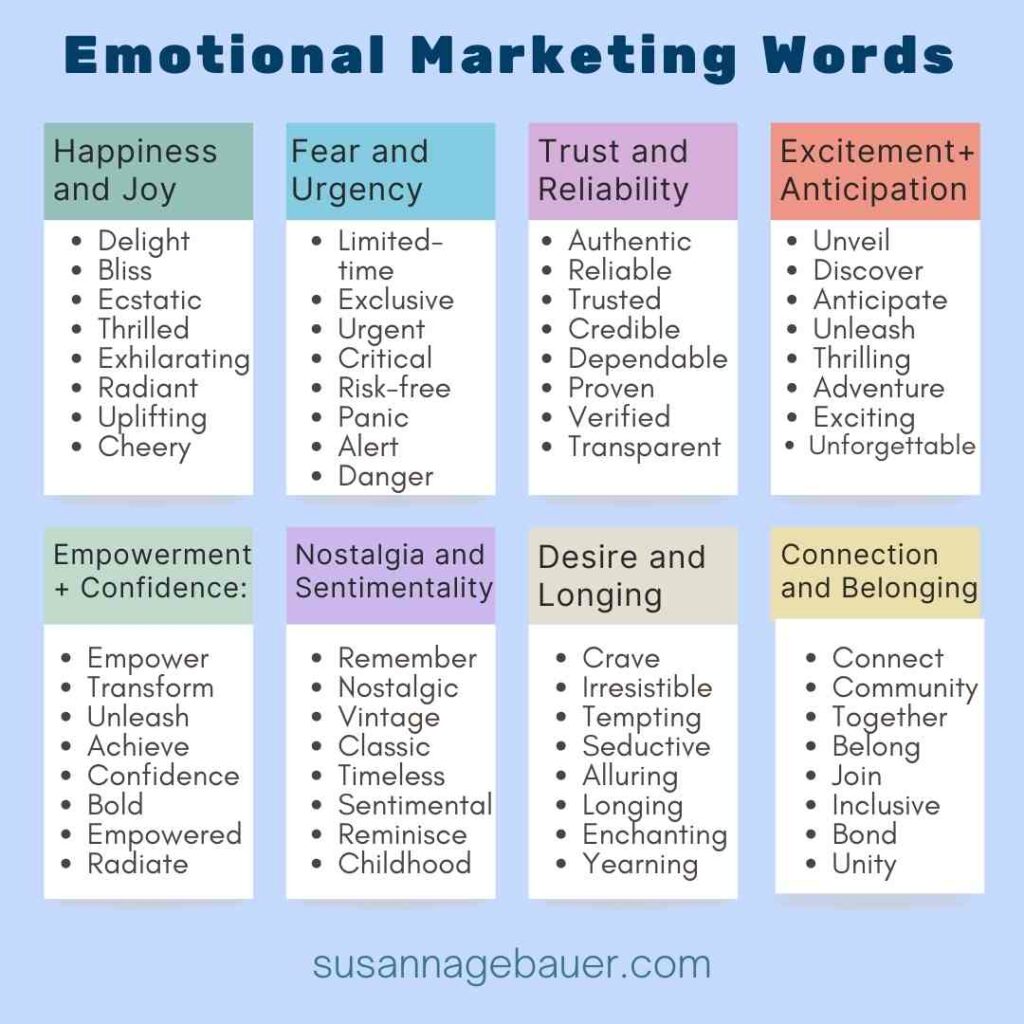
Emotional marketing words are words and phrases that are strategically chosen to evoke specific emotions and feelings in consumers. There are more personal emotional trigger words that everyone has, words that we love or hate or that we connect to an experience we had.
But there are also words that (almost) everyone associates with the same emotions. If you want to induce this emotion, you can make use of these words.
Emotional marketing words can help convey the benefits, values, and experiences associated with a particular offering.
Use visuals
Visuals have great power in content. If you want to use images to evoke emotions in your audience, you need to know who you are talking to: Different audiences have different preferences.
Also, stay targeted with your images. Make sure they are a good match to your content.
I am a great fan of creating my own images in contrast to using stock photos. I believe stock images are impersonal and that’s why they are not the best fit to evoke emotions.
- Visual storytelling is always powerful to inspire emotions, think about graphic novel-type content that makes stories visual.
- People’s faces, colors, animals, and landscapes are also powerful images for emotional content.
- Memes and GIFs can also be great to evoke emotions, especially humor and sympathy.
Be authentic
Content that only you can provide has the most power to work in your favor and evoke stronger emotions than content people can find everywhere.
I have made the experience that the best and most thorough list post does not have the same marketing power as a personal story told in my own words and from my own perspective.
Unique and personal stories can turn a boring topic into a powerful piece of emotional content.
Know your audience
Understanding your audience can help you to create the content that speaks to them.
Often what is emotional for some people may not be emotional for other groups of people.
For instance, while images of babies and small children may be powerful with young parents, they may not be the best content to hit the emotional button of adolescents.
Be genuine
People can spot a fake from a mile away, so make sure your emotions are genuine. If you’re not passionate about your topic, your audience won’t be either. That is one reason why just copying other people’s emails or sales copy will often not bring the results you are looking for.
That was a lot of theory. Time to take a look at emotions in action.
Examples of emotional content marketing
I am a person who can learn best from examples. The theory is good for understanding the basics. But only when I see the theory put to use can I imagine how this will work for me.
I tried to choose a broad variety of examples to give you an impression of how diverse the use cases for emotional marketing are.
The “boring” launch story that never gets old
You have probably read hundreds of these stories:
“Here is where I started and how I got here. If you buy my course, you will instantly get from where you are now to where you always wanted to be.”
I considered linking to a course page here for illustration, but the thing is, launch pages never exist for long – they usually close when the launch is over.
There are hundreds of similar stories because these stories work.
If told right they trigger many emotions:
- Fear of missing out – You want the same success story or you would not be reading it
- Belonging, community – The storyteller is one of you, with the same background, and the same struggles only they share the solution that you are seeking
- Trust: Most of these stories include a bunch of testimonials and praise for the product. If done right, you already trust this product owner because they shared a lot of value before the launch
- Gratitude: A launch usually consists of a couple of valuable launch emails or videos before that “cart open” day. Done right, the value is so high that everybody ending up on the landing page with the story already is very thankful for all the value they got before the launch. I admit that I love launches, you always get a ton of value out of the launch emails, webinars or videos even if I have no intention of buying the product.
For pitty’s sake

If you are active on the web, you know these stories:
- children starving
- children working in bad conditions at an age when we would expect them to go to school
- dogs living on the street or videos of dogs in bad condition evolving to healthy dogs through the help of a dog rescue
These stories play with our emotions to get us to donate money or adopt a dog:
- guilt – for living a better and easier life
- empathy – we can almost feel the suffering and hurting of the children or dogs. It makes our hearts ache to watch the images.
- gratitude – We are grateful for the people in the shelter or the aid organization who do their best to help the children and animals so that we don’t have to bother
Dog’s gone wrong
Not all emotional content is good marketing content.
A couple of years back, Budweiser had some hugely successful marketing videos for Super Bowl ad spots called “Puppy love.”
After 2 years they changed their ad story completely why?
Because the puppy videos were successful when it came to views, sympathy, and sharing of the videos. But the stories they told were obviously not selling beer.
Budweiser’s Puppy Love commercial (2014) is the all-time most popular Super Bowl ad with more than 50M views. The question of whether this commercial brought Budweiser enough sales is disputed.
The world’s biggest beermaker announced this week that the puppy is history–virtual roadkill in the almighty marketing plan aiming for better beer sales.
Equus, 2017
While there remains doubt if the outcome of the commercials was really that bad, it brings into focus a question that is relevant when you aim for emotional content marketing:
How far from your main topic should you stray with your emotional stories?
It’s clear that puppies and animals can trigger emotions. But can we now all create more cat content and win the marketing game? I doubt it.
You cannot sell social media marketing expertise or consulting by simply sharing funny images of cats or dogs!
It is a thin line between aiming for emotions and missing the point.
- Keep in mind that you are still writing for an audience: your emotional content still has to provide value for your target group.
- Emotional content marketing needs stories that are related to what you want to achieve. If you want to sell a Twitter course, tell the story of how you conquered Twitter. If you are selling sales funnel optimization, talk about lead magnets, sales pages and email sequences.
Emotional content is a powerful tool.
Consider the endless number of awesome pieces of content out there. Which ones will people remember? The content that made them feel something.
Even if you have the most useful content, without emotions, it will blur into all the other useful tips and tricks people find online.
What will help you connect, be remembered, and build a community around your content is the emotions you share and the stories you tell!

